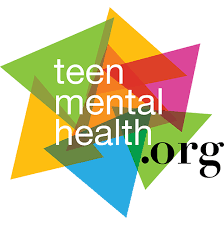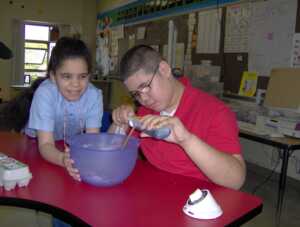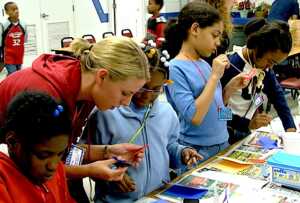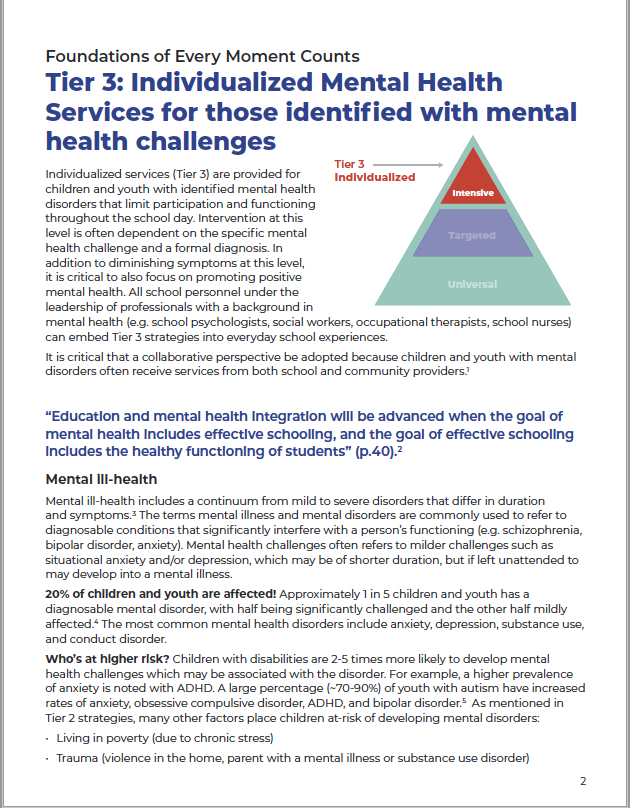Tier 3 Individualized
On Demand Webinars:
Developed by Occupational Therapists, implemented by all!
Learn practical tools and strategies for positive mental health outcomes in your classroom, school, or community. Unlock instant savings when you purchase for a group or bundle multiple webinars together.
Downloads:
 Learn about the Mental Health & High School Curriculum Guide at Teenmentalhealth.org.
Learn about the Mental Health & High School Curriculum Guide at Teenmentalhealth.org.
"Raising children...is vastly more than fixing what is wrong with them. It is about identifying and nurturing their strongest qualities, what they own and are best at, and helping them find niches in which they can best live out these strengths." (Seligman & Csikszentmihalyi, 2000, p. 6)

Tier 3: Individualized Mental Health Services
For children and youth with identified mental health challenges
Individualized services (MTSS Tier 3) are provided for children and youth with identified mental health disorders that limit participation and functioning throughout the school day. Intervention at this level is often dependent on the specific mental health challenge and a formal diagnosis. In addition to diminishing symptoms at this level, it is critical to also focus on promoting positive mental health. All school personnel under the leadership of professionals with a background in mental health (e.g. school psychologists, social workers, occupational therapy practitioners, school nurses) can embed MTSS Tier 3 strategies into everyday school experiences.
Collaboration is key! It is critical that a collaborative approach be adopted because children and youth with mental disorders often receive services from both school and community providers.1

Tier 3: Remember This! Foster comprehensive mental health literacy
- Be knowledgable
- Be observant
- Make a connection
- Foster help-seeking
- Promote successful participation
 Mental ill-health includes a continuum from mild to severe disorders that differ in duration and symptoms.3 The terms mental illness and mental disorders are commonly used to refer to diagnosable conditions that significantly interfere with a person’s functioning (e.g. schizophrenia, bipolar disorder, anxiety). Mental health challenges often refers to milder challenges such as situational anxiety and/or depression, which may be of shorter duration, but if left unattended to may develop into a mental illness.
Mental ill-health includes a continuum from mild to severe disorders that differ in duration and symptoms.3 The terms mental illness and mental disorders are commonly used to refer to diagnosable conditions that significantly interfere with a person’s functioning (e.g. schizophrenia, bipolar disorder, anxiety). Mental health challenges often refers to milder challenges such as situational anxiety and/or depression, which may be of shorter duration, but if left unattended to may develop into a mental illness.
20% of children and youth are affected! Approximately 1 in 5 children and youth has a diagnosable mental disorder, with half being significantly challenged and the other half mildly affected.4 The most common mental health disorders include anxiety, depression, substance use, and conduct disorder.
Who’s at higher risk? Children with disabilities are 2-5 times more likely to develop mental health challenges which may be associated with the disorder. For example, a higher prevalence of anxiety is noted with ADHD. A large percentage (~70-90%) of youth with autism have increased rates of anxiety, obsessive compulsive disorder, ADHD, and bipolar disorder.5 As mentioned in Tier 2 strategies, many other factors place children at-risk of developing mental disorders:
- Living in poverty (due to chronic stress)
- Trauma (violence in the home, parent with a mental illness or substance use disorder)
- Experiencing loss and grieving (e.g. loss of a family member, friend, or pet; parental divorce)
- Bullying
- Overweight or obese (higher incidence of self-esteem issues and depression)
- Genetic predisposition to mental illness (i.e. family history of depression)6
 For students with mental disorders, participating successfully in school may be challenging and take a lot more effort. It’s important that all school personnel be sensitive to their challenges and empathetic.
For students with mental disorders, participating successfully in school may be challenging and take a lot more effort. It’s important that all school personnel be sensitive to their challenges and empathetic.
They may show difficulty in the areas of:
- Thinking – difficulty paying attention and concentrating leading to incomplete work, disorganization, and/or poor test grades
- Mood – being anxious, irritable, withdrawn, sad
- Behavior – either low or excessive energy, socially withdrawn, changes in sleep and hygiene
What you can do?
Be respectful and kind.
All school personnel need to model being respectful and kind to students who struggle with mental health challenges. This is the first step in reducing the stigma associated with mental ill-health and possible bullying. Encourage peers to be respectful to students who are struggling emotionally and reach out to them in sensitive ways.
Comprehensive mental health literacy involves being knowledgeable about the entire mental health continuum and applying a mental health promotion, prevention, and intervention framework.7 Five key strategies make up comprehensive mental health literacy:
1) Be knowledgeable: All school personnel and students need to learn about positive mental health as well as the symptoms associated with a variety of mental health problems (e.g., depression, anxiety, obsessive-compulsive disorder, schizophrenia). In addition, it’s important to learn how such symptoms might impact school function and social relationships. The goal is not to diagnose, but to be aware of the symptoms and their impact on participation. How?
Read and discuss information sheets about mental disorders and how to help. Consider sharing these at staff meetings. See if the mental health providers in the school can take the lead (e.g. school counselors, school psychologists, social workers). School nurses and occupational therapists also have expertise in the area of mental health. See the free resources below. Use Canada’s Mental health and high school curriculum guide (2017).7
Consider embedding mental health literacy activities in meaningful and relevant ways throughout the school day for all students. Refer to Embedded Strategies and mental health literacy. Simple examples include having students read books to inform them as a part of language arts followed by discussion.
 2) Be observant: Tune into signs and symptoms that may be present in students who are experiencing mental health challenges. Significant and sudden changes need to be noted. A ‘sign’ is something observable (e.g. crying, withdrawal) and a ‘symptom’ is something that is felt that may not be observable (e.g. anxiety, sadness, delusions, hallucinations). Signs and symptoms may include:
2) Be observant: Tune into signs and symptoms that may be present in students who are experiencing mental health challenges. Significant and sudden changes need to be noted. A ‘sign’ is something observable (e.g. crying, withdrawal) and a ‘symptom’ is something that is felt that may not be observable (e.g. anxiety, sadness, delusions, hallucinations). Signs and symptoms may include:
Emotions – depressed mood, excessive irritability, anxiety, feeling hopeless
Thinking – pessimism, difficulty making decisions, rigid thinking, poor concentration
Functional behavior – social withdrawal, appetite changes, sleep changes, academic difficulties
Physical – headaches, nausea, excessive movement
 3) Make a connection: All school personnel can make early contact with a student who may be demonstrating emotional challenges. Since there are usually only 1-2 licensed mental health providers in a given school, it’s important for all adults to ‘make mental health their business’. How should you do this? First, look for an opportunity to talk with the student privately. Use ‘I statements’ to communicate your concern (e.g. “I noticed that you’re keeping to yourself lately. I wanted to see how you’re doing.") Use open-ended questions (e.g. “How are you feeling?”) and wait for a response. Convey caring and respect in your nonverbal language (show sincere interest and acceptance). If the student doesn’t want to talk, indicate ‘you’re there for them’ and will check back to see how they’re doing.
3) Make a connection: All school personnel can make early contact with a student who may be demonstrating emotional challenges. Since there are usually only 1-2 licensed mental health providers in a given school, it’s important for all adults to ‘make mental health their business’. How should you do this? First, look for an opportunity to talk with the student privately. Use ‘I statements’ to communicate your concern (e.g. “I noticed that you’re keeping to yourself lately. I wanted to see how you’re doing.") Use open-ended questions (e.g. “How are you feeling?”) and wait for a response. Convey caring and respect in your nonverbal language (show sincere interest and acceptance). If the student doesn’t want to talk, indicate ‘you’re there for them’ and will check back to see how they’re doing.
4) Foster help-seeking: Follow your school or clinic’s protocol for how and who to share your observations and mental health concerns (e.g. school counselor, RtI team, principal). If you don’t know your school’s protocol, get information from your principal. With the student, ‘normalize’ the conversation about seeking help (e.g. ‘Mental health challenges are common. Talking to a counselor can help you learn ways to help you feel better emotionally.) Talk positively about seeking help. Encourage the youth to engage in activities known to promote positive mental health, such as healthy eating, having a daily routine, getting enough sleep, and regular exercise.
 5) Promote successful participation for those with mental health challenges. Foster respectful interactions and inclusion. Children and youth with identified mental health challenges attend school. It’s important for all school personnel to have some basic knowledge on how to help students who are struggling emotionally be able to participate successfully throughout the day. Close collaboration with relevant mental health providers and the team is critical for ensuring that MTSS Tier 3 strategies are applied consistently. In terms of communication, it’s essential that all adults talk respectfully and supportively with students who are dealing with mental health challenges. They may have difficulty concentrating and find school overwhelming. It may be helpful to talk in private to avoid embarrassment. Keeping conversations short and simple, repeat instructions as needed, and give students time to respond.8
5) Promote successful participation for those with mental health challenges. Foster respectful interactions and inclusion. Children and youth with identified mental health challenges attend school. It’s important for all school personnel to have some basic knowledge on how to help students who are struggling emotionally be able to participate successfully throughout the day. Close collaboration with relevant mental health providers and the team is critical for ensuring that MTSS Tier 3 strategies are applied consistently. In terms of communication, it’s essential that all adults talk respectfully and supportively with students who are dealing with mental health challenges. They may have difficulty concentrating and find school overwhelming. It may be helpful to talk in private to avoid embarrassment. Keeping conversations short and simple, repeat instructions as needed, and give students time to respond.8
The team, student, and family need to work together to make accommodations to the learning expectations based on the student’s specific needs. Learn about 504 Plans and accommodations that can be made based on the diagnosis. For example, a student with ADHD and/or anxiety may need extra time to complete assignments and during test-taking. Think about how to reduce stress in the classroom, such as having a quiet area for students who become overwhelmed with noise or providing a classroom pass for a 5-10 minute break when a student is having symptoms. It’s also helpful to embed small activities throughout the day to help all students cope with stress. Refer to the Calm Moments Cards for how to embed thinking, calming, and focusing activities throughout the day.
 Minnesota Association for Children’s Mental – Mental Health Fact Sheets. These 2-page fact sheets provide useful information about common mental disorders (e.g. anxiety, depression, ADHD) and practical classroom strategies for helping students succeed in school. To download these fact sheets, refer to the Publications tab and sign up to receive free copies.
Minnesota Association for Children’s Mental – Mental Health Fact Sheets. These 2-page fact sheets provide useful information about common mental disorders (e.g. anxiety, depression, ADHD) and practical classroom strategies for helping students succeed in school. To download these fact sheets, refer to the Publications tab and sign up to receive free copies.
 American Occupational Therapy Association’s (AOTA) – School Mental Health toolkit. This is a compilation of information sheets on issues related to mental health such as common disorders (e.g. anxiety), factors that place children at-risk (grieving & loss, obesity, bullying), and environmental stressors (e.g. trauma, cafeteria issues). Each information sheet provides how the issue impacts participation and incorporates many of the same strategies as MTSS Tier 3 for mental health promotion, prevention, and intervention.
American Occupational Therapy Association’s (AOTA) – School Mental Health toolkit. This is a compilation of information sheets on issues related to mental health such as common disorders (e.g. anxiety), factors that place children at-risk (grieving & loss, obesity, bullying), and environmental stressors (e.g. trauma, cafeteria issues). Each information sheet provides how the issue impacts participation and incorporates many of the same strategies as MTSS Tier 3 for mental health promotion, prevention, and intervention.
 Teenmentalhealth.org – This website is committed to providing high quality mental health literacy information, research, education, and resources. Learn about the Mental Health & High School Curriculum Guide (version 3, 2017) by Kutcher, S. & Wei, Y. which is being used in Canada. This guide provides information for teachers on how to implement a comprehensive, system-wide approach to teaching mental health literacy as a part of the health curriculum. As of 2020, the guide is free and downloadable on the teenmentalhealth.org website. Information included: positive mental health, symptoms of mental disorders, reducing symptoms, and promoting help-seeking behavior. Research has demonstrated that the 6-week program was effective in improving mental health knowledge and attitudes toward mental illness.9
Teenmentalhealth.org – This website is committed to providing high quality mental health literacy information, research, education, and resources. Learn about the Mental Health & High School Curriculum Guide (version 3, 2017) by Kutcher, S. & Wei, Y. which is being used in Canada. This guide provides information for teachers on how to implement a comprehensive, system-wide approach to teaching mental health literacy as a part of the health curriculum. As of 2020, the guide is free and downloadable on the teenmentalhealth.org website. Information included: positive mental health, symptoms of mental disorders, reducing symptoms, and promoting help-seeking behavior. Research has demonstrated that the 6-week program was effective in improving mental health knowledge and attitudes toward mental illness.9
1Sebian, J., Mettrick, J., Weiss, C., Stephan, S., Lever, N., & Weist, M. (2007). Education and system-of-care approaches: Solutions for educators and school mental health professionals. Baltimore: Center for School Mental Health Analysis and Action, Department of Psychiatry, and University of Maryland School of Medicine. 2Atkins, M. S., Hoagwood, K. E., Kutash, K., & Seidman, E. (2010). Toward the integration of education and mental health in schools. Administration and Policy in Mental Health, 37, 40–47. http://dx.doi.org/10.1007/s10488-010-0299-7 3 Barry, M. M., & Jenkins, R. (2007). Implementing mental health promotion. Edinburgh: Churchill, Livingstone, Elsevier. 4National Research Council & Institute of Medicine. (2009). Preventing mental, emotional, and behavioral disorders among young people: Progress and possibilities. Washington, DC: National Academies Press. 5Salazar, F., et al. (2015). Co-occurring psychiatric disorders in preschool and elementary school-aged children with ASD. Journal of Autism & Developmental Disorders, 45, 2283-94. http://doi.org/10.1007/s10803-015-2361-5 6Bazyk, S. (Ed.). (2011). Mental health promotion, prevention, and intervention with children and youth: A guiding framework for occupational therapy. Bethesda, MD: AOTA Press. Link: https://myaota.aota.org/shop_aota/prodview.aspx?TYPE=D&PID=326607255&SKU=900470U 7Kutcher, S., & Wei, Y. (2017). Mental Health & High School Curriculum Guide (Version 3). http://teenmentalhealth.org/curriculum/ 8Mental Health America. (2017). Tips for teachers: Ways to help students who struggle with emotions or behavior. http://www.mentalhealthamerica.net 9Milin, R. et al. (2016). Impact of a mental health curriculum on knowledge and stigma among high school students: A randomized controlled trial. Journal of the American Academy of Child and Adolescent Psychiatry, 55(5), 383-391. 10Seligman, M. E. P., & Csikszentmihalyi, M. (2000). Positive psychology: An introduction. American Psychologist, 55, 5-14.

